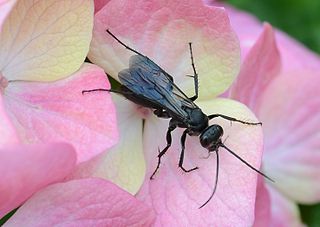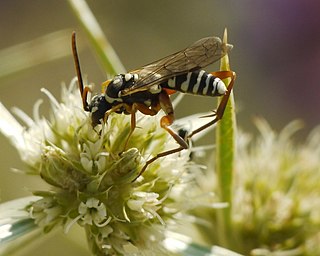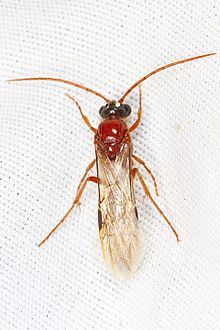
Tiger beetles are a large group of beetles, from the Cicindelinae subfamily, known for their aggressive predatory habits and running speed. The fastest known species of tiger beetle, Cicindela hudsoni, can run at a speed of 9 km/h, or about 125 body lengths per second. As of 2005, about 2,600 species and subspecies were known, with the richest diversity in the Oriental (Indo-Malayan) region, followed by the Neotropics.

The Ichneumonidae, also known as the ichneumon wasps or ichneumonids, is a parasitoid wasp family within the insect order Hymenoptera. This insect family is among the most species-rich branches of the tree of life. At the same time, it is one of the groups for which our knowledge most severely lags behind their actual diversity. The roughly 25,000 species described today probably represent less than a quarter of their true richness, but reliable estimates are lacking, as is much of the most basic knowledge about their ecology, distribution and evolution. Ichneumonid wasps, with very few exceptions, attack the immature stages of holometabolous insects and spiders, eventually killing their hosts. They thus fulfill an important role as regulators of insect populations, both in natural and semi-natural systems, making them promising agents for biological control.

The family Agaonidae is a group of pollinating and nonpollinating fig wasps. They spend their larval stage inside the fruits of figs. The pollinating wasps are the mutualistic partners of the fig trees. The nonpollinating fig wasps are parasitic. Extinct forms from the Eocene and Miocene are nearly identical to modern forms, suggesting that the niche has been stable over geologic time.

Vespoidea is a superfamily of wasps in the order Hymenoptera, although older taxonomic schemes may vary in this categorization, particularly in whether to recognize the superfamilies Scolioidea or Formicoidea. Vespoidea includes wasps with a large variety of lifestyles: eusocial, social, and solitary habits, predators, scavengers, parasitoids, and some herbivores.

The Tiphiidae are a family of large, solitary wasps whose larvae are parasitoids of various beetle larvae, especially those in the superfamily Scarabaeoidea. Until recently, this family contained several additional subfamilies, but multiple studies have independently confirmed that these comprise a separate lineage, and are now classified in the family Thynnidae.

Rhopalosomatidae is a family of Hymenoptera containing about 68 extant species in four genera that are found worldwide. Three fossil genera are known.

The Trigonalidae are one of the more unusual families of hymenopteran insects, of indeterminate affinity within the suborder Apocrita, and presently placed in a unique superfamily, Trigonaloidea, and the only extant taxon in the superfamily. The other taxa is an extinct family named Maimetshidae though it is sometimes included in Megalyridae making Trigonalidae the only member in Trigonaloidea. Trigonalidae are divided into 7 subfamilies; Orthogonalinae, Trigonalinae, Seminotinae, Bareogonaloinae, Platygonalinae, Nomadininae, and Lycogastrinae. These wasps are extremely rare, but surprisingly diverse, with over 90 species in over 30 genera and 7 subfamilies, and are known from all parts of the world. It is possibly the sister group to all Aculeata.
The Euparagiinae are a small subfamily of rare wasps in the family Vespidae containing the single genus Euparagia. The group had a cosmopolitan distribution in past geological times, but is now a geographically relict taxon known only from the desert regions of the Southwestern United States and northwestern Mexico.

Microgastrinae is a subfamily of braconid wasps, encompassing 2,000 described species, with an estimated 5,000-10,000 total species. This makes it one of the richest subfamilies with the most species of parasitoid wasps.

Tiphia femorata, often known as a beetle-killing wasp or common tiphiid wasp, is a species of wasp belonging to the family Tiphiidae, subfamily Tiphiinae.

Anoplius nigerrimus is one of the most common spider wasps, or pompilids, in Europe. They are mostly black and the females are 6-8 mm long while males measure 5-8 mm. This species may be distinguished from the related Anoplius concinnus and Anoplius caviventris by the 20 setae, or hairs, on the forehead rather than 60 or 45.

The Ceropalinae are a subfamily of the Pompilidae, the spider wasps, containing two genera, whose members are kleptoparasitic on other solitary wasps which hunt spiders, mainly fellow members of the Pompilidae.

Agroecomyrmecinae is a subfamily of ants containing two extant and two fossil genera. The subfamily was originally classified in 1930 by Carpenter as Agroecomyrmecini, a Myrmicinae tribe. Bolton raised the tribe to subfamily status in 2003, suggesting that Agroecomyrmecinae might be the sister taxon to Myrmicinae. It has since been discovered to be one of the earliest lineages of ants, a clade from the basal polytomy for all ants. In 2014, the subfamily was expanded to two tribes. The tribe Ankylomyrmini was moved from the subfamily Myrmicinae to Agroemyrmecinae.
Ireangelus is a genus of kleptoparasitic spider wasps from the sub-family Ceropalinae of the family Pompilidae. The genus has a pan tropical distribution, being known from Oriental, Neotropical, Australian, eastern Palearctic, and Madagascan Zoogeographic regions being best represented in the Neotropics. Irenangelus is closely related to the more widespread genus Ceropales, the two genera forming a monophyletic subfamily, Ceropalinae within the Pompilidae. This is regarded as the most basal grouping of the Pompilidae but this view is problematic because of the kleptoparasitic life history of the Ceropalines, it is now considered that they Ceropalines and other pompilids evolved from a common ectoparasitoid ancestor.

The Thynnidae are a family of large, solitary wasps whose larvae are almost universally parasitoids of various beetle larvae, especially those in the superfamily Scarabaeoidea. Until recently, the constituents of this family were classified in the family Tiphiidae, but multiple studies have independently confirmed that thynnids are a separate lineage.

Tiphiinae is one of the two subfamilies of the flower wasp family Tiphiidae, the other being the Nearctic Brachycistidinae. It is the larger of the two and has a worldwide distribution.

Myzinum is a genus of wasps in the family Thynnidae. There are 63 species presently recognized in Myzinum.

Amiseginae is a subfamily of cuckoo wasps in the family Chrysididae. There are more than 30 genera and 150 described species in Amiseginae.

Loboscelidiinae is a subfamily of cuckoo wasps in the family Chrysididae. There are at least 2 genera and more than 40 described species in Loboscelidiinae.
















